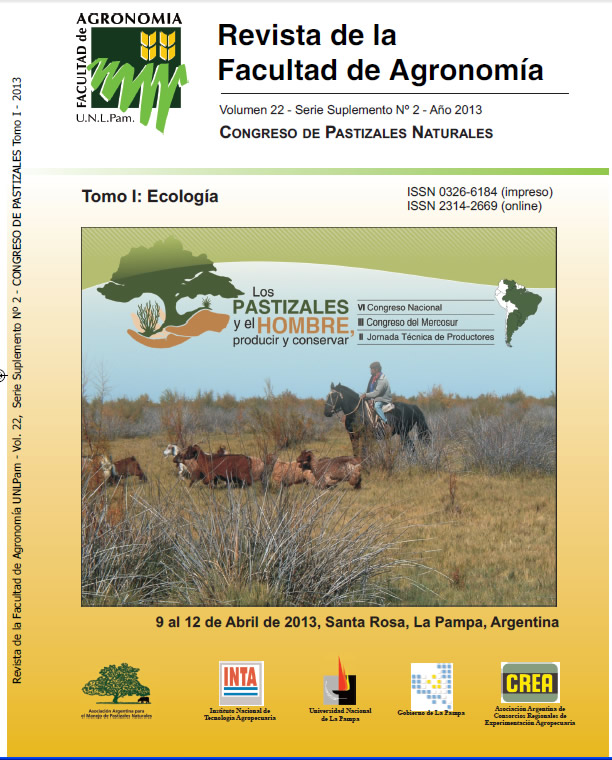Rumen degradability of weeping lovegrass (Eragrostis curvula (Schrad.) Nees) along the annual cycle in La Pampa
Keywords:
Nutritive value, Aerial biomass, Degradability in situ, Weeping lovegrassAbstract
The perennial forage most commonly used as complement of grasslands in La Pampa is weeping lovegrass. This work studied the initial solubility (IS) and the effective degradability (ED) of weeping lovegrass forage along the whole cycle. Five cuts were done on the following dates: November 16th, January 14th, March4th, May 15th and July 1st. The forage was divided in two fractions, sheath and stem, and incubated in the rumen of 3 fistulated Hereford steers, in nylon bags, for 3, 6, 9, 12, 24, 48, 72 and 96 hours. The IS was estimated by submerging the samples in distilled water at 39°C for 15 minutes, under constant movement. The ED of dry matter was estimated by summing up the partial disappearances, at prefixed outflow rate. The results were subjected to analysis of variance and Tukey (p < 0.05). The values of IS were similar, for the sheath fraction, in cuts 1 and 2, and clearly lower (p<0,05) from cut 3 onwards. The IS of the stem fraction showed low values from the first cut. The ED of the sheath fraction was almost 35% in cuts 1 and 2, and higher than the ED of cuts 4 and 5 (p< 0.05). The stem’s ED was low in all cuts, with no differences between them. It is concluded that the strategy of utilization of this species should be directed to obtain the highest possible sheath proportion. This study confirms that the nutritive value of weeping lovegrass is low, both as green and deferred forage.
Downloads
References
Covas G. 1974. Los pastos sudafricanos en relación a la forrajicultura en La Pampa, con especial referencia al pasto llorón (Eragrostis curvula). Simposio sobre Pasto Llorón en la Provincia de La Pampa. pp. 1-10.
Ferri C.M. 2002. Implicancias del diferimiento de la utilización de Panicum coloratum L. sobre el consumo de ovinos en pastoreo. Tesis doctoral, Unidad Integrada Balcarce, Universidad Nacional de Mar del Plata. pp.156.
Ferri C.M., V.V Jouve, N.P. Stritzler & H.J. Petruzzi. 1998. Estimation of intake and digestibility of Kleingrass from in situ parameters in sheep. Anim. Sci. 67: 535- 540.
Gargano O.A. & M.A. Adúriz. 1984. Manejo de la defoliación y fertilización nitrogenada en pasto llorón, Eragrostis curvula cv. Tanganyka. I. Rendimiento de material seca, digestibilidad in vitro y rendimiento de materia seca digestible. Rev. Fac. Agron. (UBA) 5: 7-14.
Huntington J.A. & D.I. Givens. 1995. The in situ technique for studying the rumen degradation of feeds: A review of the procedure. Nut. Abstr.Rev.(Series B) 65: 63-93.
Jung H.G. & M.S. Allen. 1995. Characteristics of plant cell walls affecting intake and digestibility of forage by ruminants. J. Anim. Sci. 73: 2774-2790.
Kristensen E.S., P.D. Møller & T. Hvelplund. 1982. Estimation of the effective protein degradability in the rumen of cows using the nylon bag technique combined with the outflow rate. Acta Agric. Scan. 32: 123-127.
Stritzler N.P., C.M. Ferri & V.V. Jouve. 1997. Comparación de modelos utilizados para estimar la desaparición de la materia seca in sacco y la degradabilidad efec tiva. Rev. Argent. Prod. Anim. 17: 353- 364.
Stritzler N.P. & H.J. Petruzzi. 2000. Gramíneas perennes estivales introducidas en zonas semiáridas, resultados y perspectivas. Actas del Congreso Nacional de Ganadería Pampeana, Santa Rosa. La Pampa, Argentina. pp. 13-17.
Stritzler N.P., C.M. Rabotnikof, H. Lorda & A. Pordomingo. 1986. Evaluación de especies forrajeras estivales en la Región Pampeana Semiárida. III. Digestibilidad y consumo de Digitaria eriantha y Bothriochloa intermedia bajo condiciones de diferimiento. Rev.Argent. Prod. Anim. 6: 67-72.
Downloads
Published
Issue
Section
License
La Editorial de la Universidad Nacional de La Pampa (EdUNLPam) exigirá a los/as autores/as la firma del siguiente documento:
La EdUNLPam lleva a cabo la publicación del artículo: (Título del Artículo) en SEMIÁRIDA Rev.Fac.Agron UNLPam ISSN 2362-4337 (impresa) ISSN 2408-4077 (en línea), del cual el/los abajo firmantes son autores de una o más partes. En el mismo acto, el/los autores entregan exclusivamente a la EdUNLPam todos sus derechos protegidos por las leyes de propiedad intelectual que rigen en la Argentina para reproducir, publicar, editar, fijar, comunicar y transmitir públicamente en cualquier formato o medio impreso o electrónico, inclusive internet, el artículo enviado a publicación e incluirlo en índices o bases de datos nacionales e internacionales. A cambio, la EdUNLPam entrega a los autores la autorización para la publicación o reimpresión con ines académicos y educativos en cualquier libro o medio de divulgación, con la sola obligación de citar el artículo original publicado en la EdUNLPam. Cada autor acuerda en que el material provisto a la EdUNLPam es un trabajo original, que no ha sido impreso o publicado en cualquier otro medio con anterioridad y que no vulnera derechos de terceros. El Primer autor tendrá la posibilidad de leer y corregir el artículo ya editado como “prueba de galera”, pero si el autor no devolviera esas correcciones de la prueba de galera dentro del tiempo especificado, el proceso de producción y publicación podrá proseguir sin la aprobación del autor. El/los autor/es no recibirán compensación monetaria de la EdUNLPam por el uso del material contenido en este artículo y asumen la responsabilidad de las opiniones vertidas en él.






.png)



22.png)



.jpg)




.jpg)
